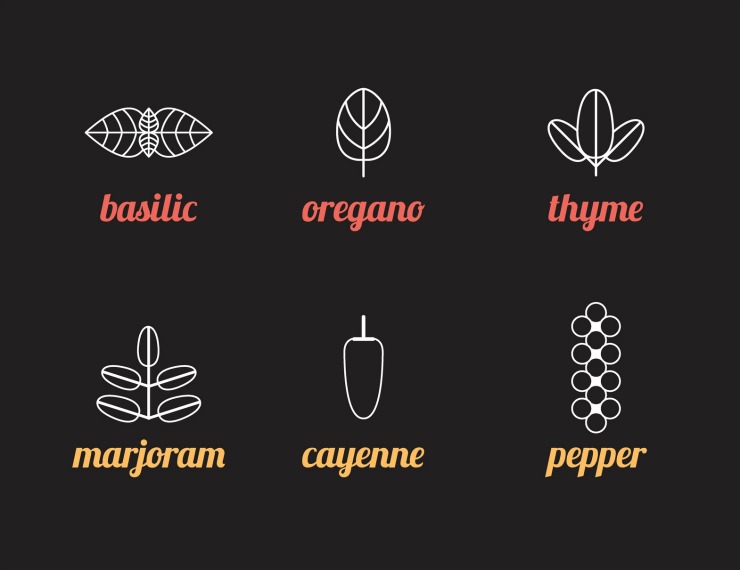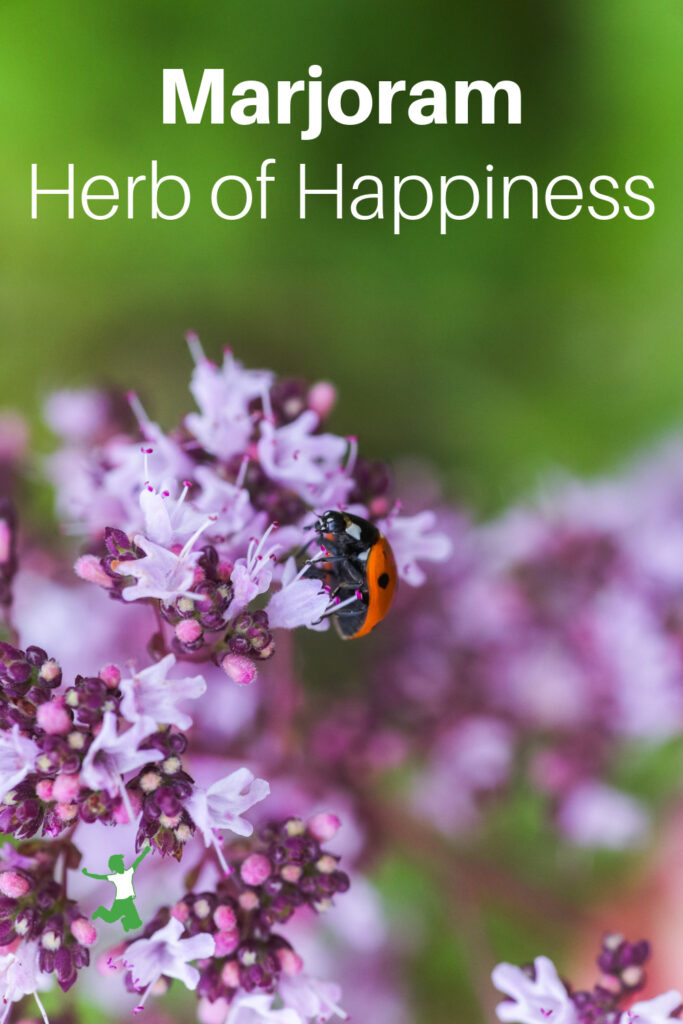Marjoram is one of the easiest herbs to grow at home. It is an excellent flavor enhancer for cooking and has utility in soap-making and medicinally for enhancing well-being, hence it’s nickname as the “happiness herb”.

I’ve grown several herbs in my indoor garden window over the years. Marjoram is one of my favorites!
After the heirloom seeds (Origanum majorana) I planted began to grow, I immediately discovered that sweet marjoram is a very easy herb to cultivate.
Growing it will make you feel like an ace gardener even if you are a novice!
Beauty and Practicality
Sweet marjoram sprouts quickly and grows bountifully.
The leaves of the marjoram plant are small, spherical, and woolly in appearance.
The grey-green leaves grow opposite each other as you can see in the image above which compares to other popular culinary herbs.
Delicate white or pink flowers bloom where the stems meet when the plant is fully mature.
When the flowers are just buds, they look like knots, which explains why a commonly used name is “knotted marjoram”.
Sweet marjoram should be picked immediately after it begins to blossom.
Consume it fresh as soon after picking as possible. This maximizes the bountiful antioxidant content.
Dry the extra at the end of the growing season for use during colder months.
Cold and Drought Hardy
Marjoram is sensitive to cold and is ideal for growing in warmer climates.
Bonus! It doesn’t easily wither like other herbs, being rather resistant to dry soil.
The downside is that I would forget to water it during dry spells as it would continue looking vibrant… drooping rather suddenly compared to other herbs with a slower wilt.
If in a colder clime, cut it back in the Fall to protect the roots.
In the Spring, regrowth will easily and quickly occur provided the winter wasn’t too cold with overly thick frost.
Marjoram does require some sun, preferably around 5 hours per day.
It even grows well on porches or garden windows which only enjoy the morning sun.
Sweet Marjoram for Cooking
The taste of sweet marjoram is similar to oregano.
Be careful not to confuse it with this herbal cousin even though oregano is sometimes referred to as “wild marjoram”.
Excluding the roots, all parts of sweet marjoram are edible including the leaves, soft stems, buds, and flowers.
This distinctive smelling herb when mature has a sugary aroma and essence.
It is best used as a savory spice in cooking, however, never sweet ones despite its name!
Marjoram is excellent for seasoning stews and meat dishes of all kinds but can also be used for veggie and egg dishes.
I use it in these recipes:
Other Uses
Artisans use marjoram for the wonderful scent it imparts to soaps and other handmade personal care products.
It holds its scent when dried better than many other herbs.
Drying herbs is very simple.
This article on how to dry homegrown basil describes the easy, straightforward process.
The same basic steps apply to marjoram and other herbs you buy fresh or grow yourself.
Be sure to store the dried marjoram properly to preserve potency during the off season.
The Happiness Herb
Historically, marjoram is known as the herb of happiness in Greek and Roman lore.
Newlyweds in these ancient cultures wore garlands of marjoram on their heads as a symbol of love and happiness.
Marjoram growing on a grave was thought to symbolize that the departed would enjoy a pleasant afterlife.
Perhaps marjoram’s reputation for enhancing happiness is due to the calm it can impart to the nervous system.
This and related medicinal benefits are outlined below.
Medicinal Benefits
Marjoram played a big role in traditional herbal medicine.
It was known primarily as a remedy for water retention (edema).
In addition, it has a reputation for relieving inflammation and pain when enjoyed as a therapeutic tea, ideally a homemade herbal infusion, although tea bags are fine in a pinch (suggested brand).
Sweet marjoram along with the wild oregano has some of the highest antioxidant properties of all culinary herbs. (1)
The essential oil of marjoram in aromatherapy is helpful for the following purposes: (2)
- Nervousness
- Insomnia
- Headaches
Contraindications
Marjoram has a tendency to induce menstruation.
Thus, it is not appropriate for pregnancy or during postpartum recovery.
Consult with your practitioner before use during nursing.
Summary
If you’ve never grown herbs before and want to start, marjoram is a good one to try first.
Easy to grow, delicious to eat, and highly antioxidant to boot.
What more could you want?
It may even confer a boost of happiness to your gardening and cooking endeavors!
(1) ORAC Value List – Top 100 Highest Antioxidant Spices, Herbs, Products
(2) 23 Surprising Benefits of Marjoram Essential Oil








Well switching to natural way is the best option to be healthy.
Check out the following link htttp://www.divinewellness.com to explore more natural way.
Hi Sarah,
This is an awesome post! Would you mind sharing it on the Wildcrafting Wednesday blog carnival? I’m sure my readers would love it! 🙂
Thanks!
~ Kathy
when i had my restaurant i made a marjoram sausage that was HUGE hit! i highly recommend
trying it in sausage (mine were in lamb casing but patties work really well too). a great complement to the sausage is lentils with caramelized onions and reduced balsamic syrup.
Would LOVE to get your recipes for the sausage, lentils and syrup. Please share! 🙂
I tried to start a packet of marjoram seed this past spring. Only one seed sprouted and I nursed it in hopes of getting something to use. It’s in a pot and too tiny to do anything with. I love the scent of it and I’m disappointed that it didn’t grow well. It didn’t come from Seeds of Change so I wonder about the quality or else I just don’t grow herbs well. On the other hand, my dill did very well.
this stuff is all over my backyard and my neighbor’s yard. going to have to start using it!
I’ve never grown marjoram – although I may try after reading this! But I’ve used dried marjoram to season local, ground pastured pork for breakfast sausage patties.
Mary Ellen
The Working Home Keeper
I grow it every year but never seem to come up with a way to use it. Most recipes that I use don’t use the herb.
That reminds me. I have to go dig it up and hope it lives in my pots for the winter. 🙂
Marjoram is a favorite herb in the traditional cooking of Poland and other eastern European countries, and has been used all over the Mediterranean region, since ancient times. Not only was it the herb of happiness, but it had a reputation for repelling evil forces and preventing illness. I like to use it in stews and pot roasts, and as a marinade ingredient.
What a timely article! I used marjoram for the first time last night in a Butternut squash soup recipe. I was thinking about what I’d do with the rest of it, then came your article. Thank you! Pizza here we come.
Marjoram: The Ancient Herb of Happiness – The Healthy Home Economist http://t.co/FZczmD06